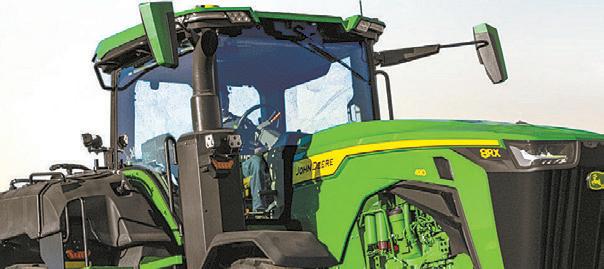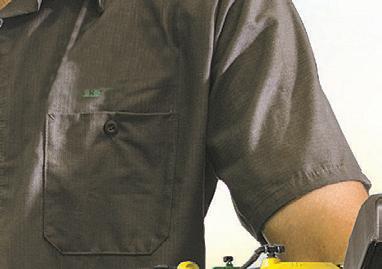






















Animal husbandry and its impact on the treatment of cattle — PAGE 7






4H and FFA kids start work on the farm — PAGE 8

Dalton’s Farm Toys opens new storefront — PAGE 10



























Animal husbandry and its impact on the treatment of cattle — PAGE 7






4H and FFA kids start work on the farm — PAGE 8

Dalton’s Farm Toys opens new storefront — PAGE 10







In an effort to protect water quality and reduce nutrient loss, the Iowa Department of Agriculture and Land Stewardship wants to work with Jasper County supervisors to install a number of bioreactors and saturated buffers between farm fields and local watersheds.


Matt McDonald, water quality initiative projects coordinator at IDALS, works on land improvement projects involving conservation practices across the state. McDonald told the board of supervisors on March 21 that the state wants to pursue a project in Jasper County to install 25 saturated buffers and bioreactors.
“We definitely want your support with this process,” McDonald said,
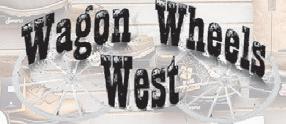
noting he has already spoken with the director of conservation to pursue the project. “…We kind of started five years ago with a proposed project on the Jasper County farm where we installed a bioreactor. It is designed and ready to go.”


Which McDonald said could be used as a demonstration as part of this initiative from the state and to showcase what the projects can do.
Bioreactors and saturated buffers act like a kidney, McDonald said. Whenever a field is tiled and drains into a waterway or ditch, the bioreactors and saturated buffers intercept that and filter the water before it is released. The state has completed projects like this Boone, Dallas, Polk and






In 2013, the State of Iowa established its nutrient reduction strategy and began experimenting with different practices to address nitrate loss from agricultural fields, McDonald said. In 2020, the state dedicated funding to install conservation practices like bioreactors, saturated buffers and wetlands.
According to a February 2022 press release from IDALS, the state partnered with the City of Ames and the Story Soil and Water Conservation District to scale up water quality practices in the South Skunk River watershed. Phase One of the project also installed 25 bioreactors and saturated buffers.

Installation of the bioreactors and saturated buffers are expected to reduce nitrogen losses by at least 40 percent.
The old approach to installing these conservation practices was the state working with individual land owners. Those land owners would be responsible for hiring, managing and paying the contractor to do the job. The state would then reimburse the land owner a certain percentage of the cost.
“This new initiative we’ve been working on is we actually go out and look for projects, 25 or 50 at a time. We batch them together, we bid them out publicly and then we install them with one contractor,” McDonald said. “What that does is we get cheaper costs and get contractors more interested in the projects.”
More land owners get interested in the practices, too, because it is more hassle-free than the old approach, McDonald said. However, since these practices are so new, the state would be meeting with land owners to survey their land before getting started with a project and share what has been done so far.
Ever since the new approach was adopted two years ago, the state has installed 250 practices around the state. Before that, about 100 were installed.
“We’ve definitely installed quite a few more practices,” McDonald said.
As part of the project in Jasper County, IDALS would identify locations for bioreactors and saturated buffers. The county would process the claims to the contractor, hold the public hearings and then be reimbursed for financing the projects. McDonald said reimbursement could be a quick turnaround, too.

The county would also establish temporary lease agreements to allow the contractor to enter onto a private land owner’s property for construction.
IDALS would handle all the “legwork” to coordinate with landowners. McDonald estimated the project would cost about $200,000.
Construction of the 25 projects in Jasper County would start in the spring and summer of 2024. IDALS wants to start near the Indian Creek watershed. McDonald, who lives in the county, has been wanting to do a project near there for a long time. But other areas in the county will be considered, too.
Supervisors were intrigued by the project, which would require a 28E agreement with Jasper County and IDALS before moving forward.
— Christopher Braunschweig








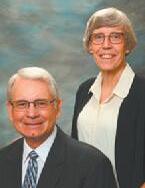

Although cattle have a pressure zone and a flight zone, the point of movement for the animal is the eye.
“When I’m working with cattle, I focus on looking where their eye is,” said Dan Thomson, professor of animal science at Iowa State University.
“If you walk behind cattle, you’ll see them switching ears and what they are doing is they’re looking at you and they’re changing eyes to see if you’re still applying pressure to move them forward,” he said. “We need to move cattle from the front so they can see us.”
Cattle have a 360-degree view, said Thomson during a presentation at the Driftless Region Beef Conference presented by University of Illinois Extension, ISU Extension and Outreach and University of Wisconsin Extension.
“The pressure zone is when they notice you and as you move towards them and apply pressure the cattle will move away from the pressure,” he said. “That’s when we release the pressure and reward them for going in the right direction.”
“When we get too close or they’re panicked, they respond out of fear,” said Thomson, who has a consulting business that is involved with about 30% of the fed cattle in the United States.
“They crave our attention and they are a trainable animal,” Thomson said. “We have to get back to husbandry and helping these animals understand we are caregivers.”
When cattle trust people, they will show clinical signs of problems such as foot rot or respiratory disease quicker.
“The biggest secret a bovine has is its health because the one that is lame or sick is the one that is preyed upon by predators,” the veterinarian said. “If they don’t view us as a friend, they’re not going to
show us clinical signs, so we have to spend time acclimating our animals.”
If cattle arrive at a feedyard, Thomson said, and they are really skittish, he starts out by just having someone stand in the middle of the pen.
“We know the sooner the cattle get acclimated, the less toe abscesses we’ll have, the earlier we’ll have BRD diagnosis and the better they will come to the feedbunk when someone is going by,” he said. “All these little things add up to huge amounts of money.”
Thomson works with improving cattle handling facilities and he likes loadouts to be flat rather than on an incline.
“Cattle can see where they’re going if it’s flat or downhill,” he said. “When cattle are not going into something, it’s usually a line of sight that they don’t know what they’re getting into.”
Using a hot shot to move cattle is a habit, Thomson said.
“No more than 10 percent of the cattle should be hit with one, and if you’re using one that often, let’s adjust your facilities,” he said.
If cattle are falling exiting a chute it is usually a problem with footing in front of the chute or the animals are required to make a quick right or left-hand turn.
“When cattle go into a facility, the reason they balk isn’t because they’re afraid of shade because we see cattle stand in shade every day,” Thomson said. “They stop because they can’t see inside.”
“Work your cattle early in the morning because the lights will be on in the facility and it’s dark outside,” Thomson said. For cattle to have traction, floors should have 1.5-inch wide and 1.5-inch deep grooves, the veterinarian said.

“It is vitally important for cattle that are going to stand there that the diamond that is left has to be big enough for the whole foot to rest on,” he said. “It’s a problem
when we have too small of squares because we want them to be able to stand flat on the non-grooved area.”
Cattlemen have several options for crowding facilities, including the Temple Tub.
“The entrance to the tub needs to be the same width as the alley coming into it,” Thomson said. “And the tub should never be more than half full.”
Another option is the Bud Box that is 20 feet long and 10 feet wide.
“It needs to be twice as long as it is wide, and with six panels, you can build a Bud Box in a pasture to move cattle into a chute,” Thomson said. “When using a Bud Box, only bring enough cattle that can fit in your snake.”
A new idea that is going into feedyards and packing plants is the Bud Tub, which is a hybrid of the Bud Box and the tub system.
“The cattle come in from an alley, go round and come back into the snake,” Thomson said. “We put this in at a packing plant and they went from six people pushing cattle around the circle tub to two people.”
The veterinarian likes solid sides on the outside wall of the snake.
“If you put open sides on the outside of a curved snake, the cattle will constantly stick their legs though them because it is a natural movement,” he said.
But on the inside wall, Thomson prefers open-sided pipe fence.
“Then I can communicate with the cattle,” he said. “With a solid inside wall the only way to communicate with the cattle is to get on top of them.”
Cattlemen should adjust the hydraulic pressure on their squeeze chute to be between 650 to 850 psi.
“If you’re building a new facility, put your water hoses and electrical cords in the ceiling instead of having them lying on the floor,” Thomson said.
— Martha Blum
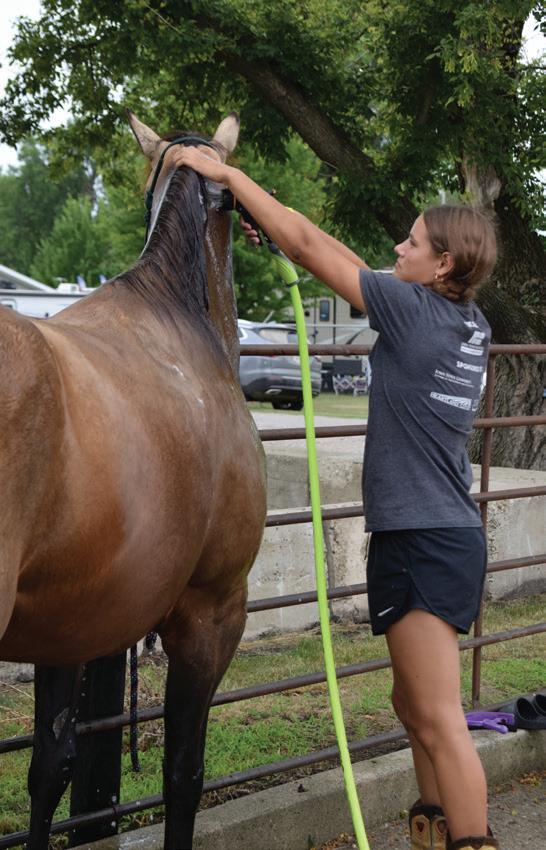

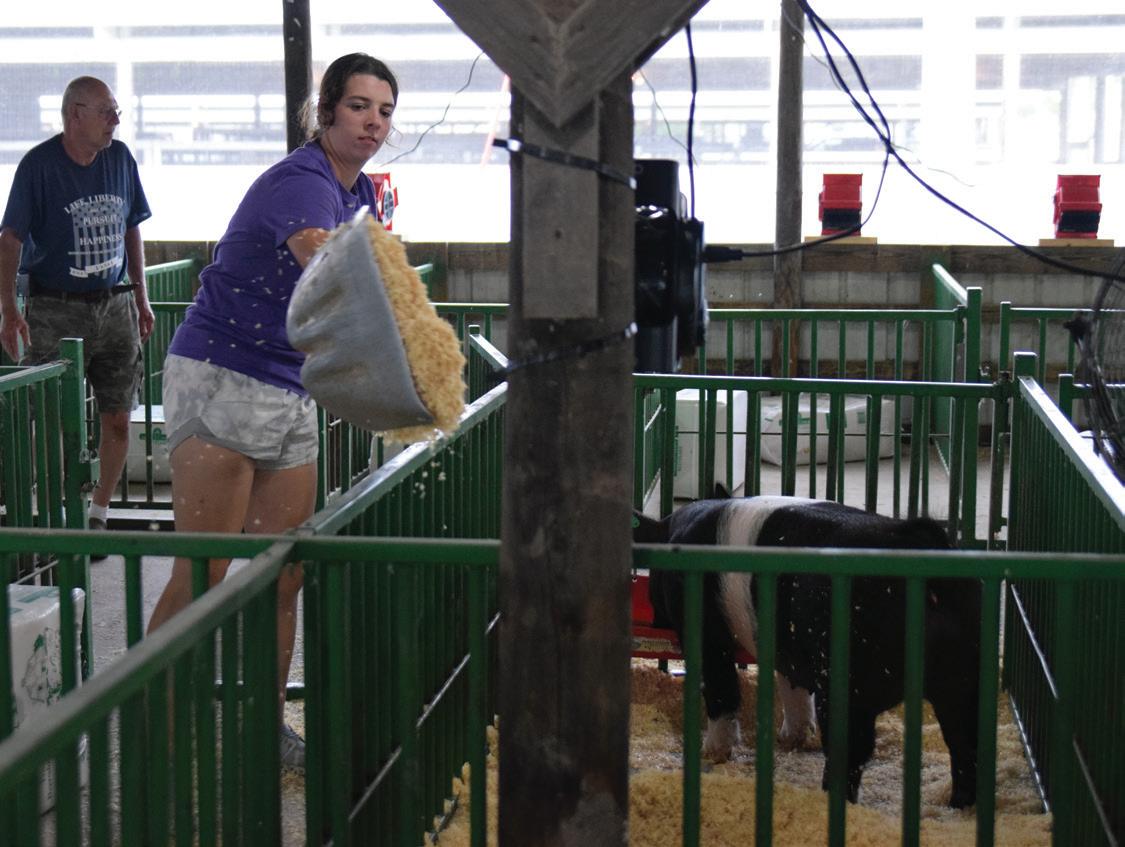
they have put in throughout the year at the July county fair








Jason Dalton turned an FFA project from high school into one of the largest farm toy businesses in the world in the span of 28 years, although for the longest time the storefront had been hidden away from passersby along Newton’s main arteries. Some people that Jason has known for years had no idea it existed.
“We sold a mower to somebody last week that I know very well,” Jason said during a recent sit-down interview with the Newton Daily News. “He lives just outside of town, and he was like, ‘So, new business? Where were you?’ I’m like, ‘Really?’”
When the toy shop wasn’t operating out of a room in Jason’s mower business, it was selling toys from an additional space across the street where boxes upon boxes of miniature tractors were nearly stacked to ceiling. It was only a matter of time before Jason and his wife, co-owner Melissa Dalton, ran out of room.
It was by sheer chance Jason and Melissa were able to secure the former Theisen’s building, 3362 Highway 6 East, as their new storefront for both the toys and the mower business, which now has an impressive showroom of Ariens- and Gravely-brand zero-turn mowers lining the floor space.
“We were out of room for both mowers and toys, and we had been looking for quite a few years,” Jason said, noting he had successfully made contact with the CEO and president of Theisen’s Home-Farm-Auo about wanting to buy the building. “It was perfect timing for this place.”
The Daltons officially acquired the building in October 2022 and began operating well into December, even though there was still inventory to be moved and shelves to install. After the holiday season and their annual toy show in Altoona, Jason and Melissa found a small window to move everything in to the new shop.
“We moved most of this in a week,” Jason said. “All the toys. All the shelves. I’d say 75 percent of that we moved in a week.”
Melissa added, “Between our kids and our employees, everybody’s worked their heads off.”
Almost 700 people showed up to the grand opening of Mow Power Dalton’s Farm Toys on March 25. The showroom was full of folks feasting on pulled pork sandwiches, ice cream and drinks. And a couple times throughout the day they got to see the Hostile Environment Pulling Team’s Busch Light tractor.
Of course, the toy room was packed with families and collectors who scoured the shelves for a specific model of John Deere, Case or Fendt tractor, or perhaps one of the 1/64 scale variants or a semi-truck or a crop duster or any other kind of agricultural equipment. Customers had their arms full at the cash register.
Several of them weren’t even from Newton, let alone Iowa. The Daltons put up a map near the entryway so customers could say where they’re from. There were customers from eight different states at the grand opening. In the past month, there have also been four different groups from Canada who visited the toy store.
“One person literally drove down here from Canada just for us,” Jason said. “I’ve said this a lot, but I almost guarantee we bring more people to Newton from out of state than any other business in town, other than a restaurant or a hotel … People will drive five to seven hours out of their way to come here on a vacation.”
Melissa added, “We always held an open house every year at the old place, and even then we would draw at least 300 people.”
People are driving miles out of their way just to get their hands on farm toys? You bet! Melissa still shakes her head about it. Collectors of all kinds love to browse the toy tractors and agricultural equipment on display. Jason said a lot of older collectors want to own smaller models of what they have farmed with.
“They want the exact replica,” he said. “There are other collectors that try to get every John Deere piece or every Farmall tractor that has ever came out. There are a lot of younger
collectors that collect the new stuff … and the younger generation has tons of people building (1/64 scale) displays.”
Of course there are also kids that come in and buy toys that they want to play with, but a large majority of sales are going toward collectors who are searching for rare toys or the last piece of a series. Some are looking for “chasers,” which Jason said are rare toys that are of a different color, oftentimes painted gold.
“It’s just like Hot Wheels with the Treasure Hunts or baseball cards with an autograph,” Jason said. “It’s the same thing with farm toys.”
Collecting is about as popular as it was when Jason started the business as an FFA project in 1995, which is great for business. Of course, Jason is a farm toy collector himself, an obsession that dates back to when he was 5 years old. He has loved them since he was a kid.
“I always spent the summers on my grandparents’ farm and just always liked tractors,” Jason said inside his office, which is completely outfitted with Ariens and Gravely memorabilia that extends well into the showroom, too. “I have too many collections.”
Probably one of his most impressive collections is displayed in a corner of its own, beyond the showroom. Illuminated by two, retro appliance store signs is a collection of Maytag treasures. In addition to the preserved washing machine, Jason displays a number of trinkets and relics that rival that of the local museum.
Miniature washing machines, pendants, employee badges, clothes pins, stamps, an unopened jar of motor oil and milk bottles from Maytag Dairy Farm. The massive collection is obviously not for sale, but it gives customers something else to marvel at while visiting the store.
To have hundreds of people show up to the grand opening of the new storefront means a lot for the Dalton family, but neither Jason nor Melissa are surprised to see a big turnout. They were kind of expecting it.
Continued Page 13












































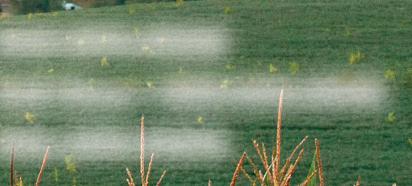
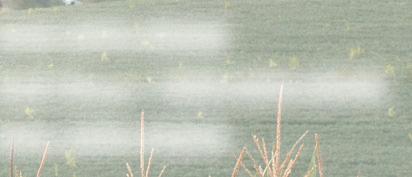


Continued Page 11
The business’ Facebook page has more than 67,000 followers, and the Daltons have built a strong reputation.
“It is now — and we can easily say this — the largest farm toy store in the world as far as floor space and toys on display. And we’re the second largest retailer of farm toys in the world,” Jason said, noting the No. 1 retailer is Outback Toys in Lititz, Penn., which was established in 1990.
Jason is also on the board of directors for the National Farm Toy Museum in Dyersville. The museum publishes a price guide every year, which Jason has been an integral part in writing and updating. The guides themselves are dense and work as a sort of checklist. In one guide, Jason has all but four pieces.
When it comes to 1/64 scale models
of farm toys, Jason is one of the most knowledgable people in the business.
“Everybody knows to come to me,” Jason said. “If they find something really rare it’ll be, ‘Ask Jason Dalton what that is. Ask him if he has it.’ My collection of 1/64 is the largest in the world. I have pretty much every piece ever made … Our name is huge.”
The new and more accessible location has certainly been a game changer for the business. The Daltons already see so much more traffic. In the past, the secluded space had its benefits. These days the family is ready for a change, and the larger floor space and higher ceilings.
As a business in Newton, Daltons Farm Toys offers a niche product. But that niche has its benefits by drawing in visitors from all across the state and

beyond. Jason and Melissa said what makes their business stand out is the knowledge and niche. Not everyone offers farm toys, nor do they know as much about them.
“If people have questions, it’s him they ask or another guy that we’re pretty good friends with,” Melissa said. “I always tell him he needs to start charging for that.”
While the Daltons have a new space to call home, they know it is only a matter of time before their collection of inventory grows beyond their store’s capacity. Already, Jason and Melissa are taking bets on how long it will take before a new addition is needed. Jason estimates five years. Melissa isn’t giving it that long.
“Well, we have the room now,” Melissa said with a laugh.
— Christopher Braunschweig
From the cockpit of his helicopter hovering above of acres and acres of corn and soybean fields, Colt Zesch can see what makes Iowa an agricultural leader. As owner, CEO and chief pilot of the aerial application business Iron Horse Aviation, he, too, plays a key role in making sure the state maintains that reputation.
Iron Horse Aviation was founded in 2016 and currently operates in Newton and Marshalltown. Zesch and his fleet of six helicopters and various contracting pilots offer a variety of services for farmers, like fungicide, insecticide, herbicide, foliar feed, test strips, field surveys and any other request the crew can muster.
Outside of aerial application, Zesch said Iron Horse Aviation also does utility work, trainings with military members, tours, power line patrol and skydiving services, and it is also looking at combating fires in the future. Zesch is doing everything he can “to keep the birds flying yearround.”
During the growing season, aerial applicators are extremely important in preventing yield loss for Iowa farmers. Diseases like tar spot can run rampant through a cornfield and severely diminish the yield and quality of the crop. From the moment the seed goes into the ground, farmers are hit with obstacles.
Which is where a business like Iron Horse Aviation comes in to play.
“Seeds can only produce so many bushels per acre, and we are just one of those pieces of the pie that helps prevent yield loss,” Zesch said. “Fungicide is the biggest thing they figured out years back. It doesn’t create more bushels per acre. That’s kind of
the wive’s tale. It just prevents bushels being lost.”
Oftentimes aerial application is conducted by planes. Iron Horse Aviation specializes in using helicopters as applicators. Zesch said farmers benefit from helicopters being able to fly slower and closer to the crop, which also improves the accuracy of the fungicide being applied.
“On average, we’re 70 to 80 mph spraying the fields,” Zesch said. “Airplanes are 140 mph on average, up to 160 mph. I don’t care how good of a pilot you are, by the time you drop in over power lines and trees and by the time that product is actually touching the corn, that pilot is already halfway through the field.”
Farmers are catching on to the use of helicopters, too. Zesch said these types of aircraft have been aerial applicators for years, more and more farmers are seeing the upsides to helicopters. Of course, good pilots make all the difference when it comes to aerial application, whether it is planes or helicopters.
Which is why Iron Horse Aviation pilots are always trying to improve their skills and the way they spray crops. Zesch said there is so much science and calibration involved in their work. Iron Horse Aviation regularly pattern tests its aircraft and equipment to make sure pilots are as efficient as possible.
“We sink a lot of money into technology and into trying to make ourselves better, even from what we are doing,” Zesch said. “It’s pretty unresting. We continue to try and better ourselves and just do the right thing. We’ve been able to grow each year, every year, just by doing the
right thing.”
Iron Horse Aviation opened its newest site this year in Newton, opening up its business to the many Jasper County farmers. Many employees are veterans or farmers themselves. Zesch is proud the business is able to serve families and preserve an agricultural way of life in the state.
“One of the biggest rewards is we really try to hire Christians, farmers or veterans within our company, and we have quite a few of those,” Zesch said. “It’s honestly quite the joy to know that God’s given us a company to be able to feed other people and grow.”
Although Zesch is a veteran, he never piloted any aircraft in the military. But he had plenty of experience jumping out of planes as a paratrooper. When he returned to civilian life, he bought his first helicopter without even knowing how to fly it. Zesch then combined his passion for aviation with the family trade.
Farming has been a way of life in Zesch’s family for more than century. Both his dad and his 93-year-old grandpa are still farming. With that background in farming fueling his efforts (he’s also working a cattle operation in tandem to working in the air), Zesch knows how important yields are to farmers.
“I got into it because we farm,” he said. “…We just want to keep going. As long as we keep getting good people and being able to feed more families, it’s wonderful to just keep moving in that direction. We’re very happy to go wherever God takes us.”
— Christopher Braunschweig







